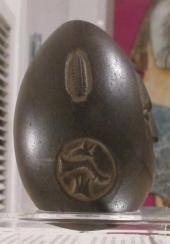More photos to help you see the new Hampshire Mystery Stone. Click on the image to get a better view!
For those seeking more information on North American language and writing systems, “The Lenâpé and Their Legends: With the Complete Text and Symbols of the Walam Olum,” by Daniel Garrison Brinton, 1885 should be of interest. This book has been re-published beautifully by Bibliolife. (A sample page is at the bottom.)
The Lenâpé, also known as the Delaware Indians, wrote in hieroglyphics as did many other tribes in North America. Unbeknownst to many, the Cherokee symbols used today did not originate after the Europeans arrival but was in use prior to their influence. Barry Fell documents in his book “America B.C.”, 1989 edition, the comparison of Micmac symbols to Egyptian Hieroglyphs, and symbols found in Iowa and Long Island to both Libyan and Egyptian. This book is packed with epigraphic documentation throughout America that demonstrates extensive interaction between Celts, Libyans, Egyptians, Chinese and other distant places with the Americas. Very little of the North American early written traditions have survived making this book an important record. The majority of their documents were inscribed on perishable mediums as is still done the world over today (including these very words!) which makes this beautiful little stone seem like an oddity. It is commonly believed that the written word was never used by native people. Yet, Brinton reports that letter writing was as common among these people as it is presently.
Evidence of interaction between these ancient cultures can be seen here. Retained in the words of the title “Walam Olum” are two important words. Brinton (pg. 104) explains the root word ‘wul’ means pleasurable sensation and so ‘wulit’ means well, good, handsome, ‘wuliken’ means it grows well and ‘walam’ is red ochre which they found very beautiful. The resemblance to the word ‘well’ is unmistakable.
‘Olum’ means score written on paper, bark or hide. In Modern English, ‘vellum’ means paper usually of a finer quality. This word comes to us from Old English ‘waelrûn’ meaning a song about death. (R and L are not always distinguished by native speakers in the same way Japanese cannot pronounce V’s.) The similarity is clearer in words such as ‘wail’, ‘wallow’ and ‘wailfyll’ or awful.

The bottom side of this small stone has a hole drilled into it which is both symbolic and functional. It allows the stone to be set on a stick for display and use during ceremonies.

The perfect image of an ear of corn is shown. Corn has a long history of appearing in religious images. It can be found in Indonesian art as well as Assyrian art. We must not forget the Roslyn Chapel, Scotland! Its perfect rows demonstrate the idea of latitude.

Another shot of the corn side. Notice the side view of the face reveals the stone was rounded before the images were carved.

Yet another view of the corn side. The empty perfect circle is directly opposite on the far side from this circle with drowning figures.

Front side of New Hampshire Mystery Stone: Are these eyes wide open? Are these eyes that are closed in contemplation? Is this a person who is bundled up warmly? Or….has this person drowned and now floats in water?
A page of the “Walam Olum” showing the hieroglyphs, the words of the story as they would be read or sung, and a translation by Brinton. He further understood each sign was traditionally accompanied by hand gestures.

“The Lenâpé and Their Legends: With the Complete Text and Symbols of the Walam Olum,” by Daniel Garrison Brinton, 1885.
Back to Previous Post
Ahead to Next Post on Noah’s Age
For further reading about this beautiful stone go…
Back to Full Post on New Hampshire Mystery Stone and see more photos.

